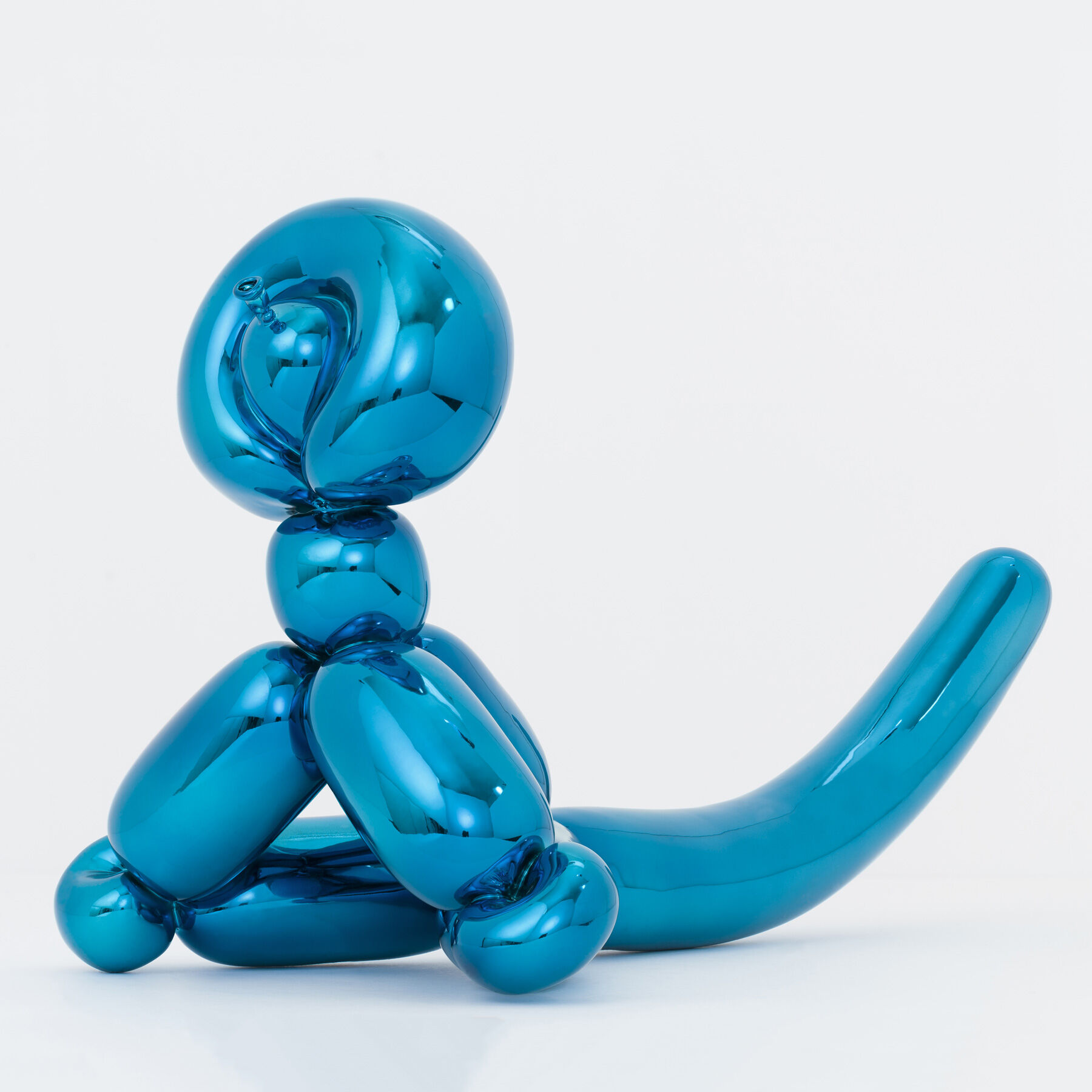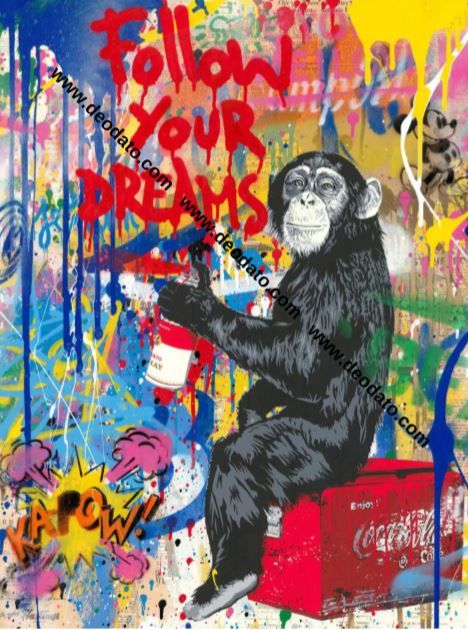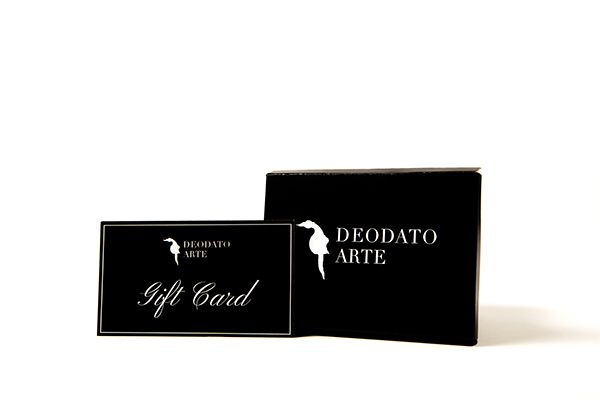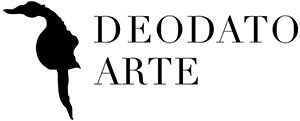
Jeff Koons and Mr. Brainwash - 5 Ideal Neo-pop and Street Art Artworks to Decorate your Spaces.
Strong emotional impact: this is the goal of Neo-pop artists.
This artistic movement aims to get the attention, to suspend for a moment the frenzy routine so to develop a personal analysis on contemporary society.
But, in such a fast paced world inhabited by billions of people, how can the Neo-pop art catch the eye?
Icons, street art and fast circulation are the answer! The icons, immediate, colourful and easely understandable, become the favourite subjects.
Neo-pop artists attentively choose known and loved characters and ordinary objects, giving to their image the task to convey a message.
This allows to transform them in a varying manifesto of an addressed reflection, yet strictly bounded to the personality of the single individual.
An illicit action impressed on walls is a functional way to make one's thoughts real: the need of escape that it generates can and has to be of example to express our thoughs and to open ourselves to comparison.
Finally, the rapid diffusion is related not only to the word of mouth, but also and mostly to digital platforms that can make an artwork known and accessible to everyone.
So, if you take a minute to reflect about the power of neo-pop art, allow me to suggest you five neo-pop artworks that could speak to you and to your guests!
Jeff Koons Neo-pop Art: Balloons Animals

As a matter of fact, the inspiration of neo-pop artists comes from the perception of tangible objects of contemporary life and from the memories that these objecs recall.
Koons sculptures, plastic figures of animals-shaped balloons, are a clear example of it.
With the new series Ballons Animals Jeff Koons managed to express the points of view from which he observes the world: the endless search for happiness, youth and sexuality are infact the main themes of all his works.
To provoke an emotional involvment of the spectator and to be versatile for all types of public are the goals that Jeff Koons set for himself and that he manages to reach by abandoning the inflated use of the production in series, so characteristic of mass production .
Jeff Koons gives his attention to the "useless", favouring unnecessary objects, like the Balloons Animals, charging them with a profound socological value.
Jeff Koons Balloon Rabbit

The work is inspired by the sculpture of the same name Ballon Rabbit 4 meters tall, sold at auction for 91,9 millions of American dollars.
Thanks to the Balloon Rabbit, Jeff Koons has become one of the most requested artists in the world and the value of his artworks keeps rising steadily.
The material used by Koons to realise the Rabbit-shaped sculpture is Limoges' enamelled reflecting porcelain, a heavy material which contrast with the idea of lightness suggested by the balloons and their shapes.
Koons porcelain therefore loose its label of noble materials, acquiring the features of glittering chocolate's paper so loved by kids.
Light, colours, balloons and rabbits have been able to bring Jeff Koons back in Pennsylvania, where the artist spent his childhood.
Unforgattable memory of those days is Easter period: the whole neighborhood filled the houses' gardens with decorative inflatable balloons, giving to the area a joyful and carefreeness vibe.
In the same way, with his Balloon Rabbit Jeff Koons wants to give joy and happiness to his public.
It is like if Koons, with these porcelain balloons, wanted to anchor dreams to the ground, to make the fleeting tangible, in a sort of gravity upsidedown, where everything seems at our reach, as in fact the kids' toys.
Jeff Koons: Balloon Monkey

Balloon Monkey, in limited edition of 999, is a testimony of Jeff Koons interest about cultural issues with universal consequences.
As a matter of fact, the monkey is one of the most recurrent themes of his artistic production, because allegoric figure suggesting a starting point for reflections about sexuality, primordial quest for pleasure and, at the same time, innocence.
In Balloon Monkey Jeff Koons combines the playful shapes of the monkey's body to the swollen tail, with a clear cross-reference to the phallus.
Balloon Monkey is therefore the perfect example of how, through a three-dimensionality fitted to the colorful sculptural quality of enamelled porcelain, contradictory concepts can be associated, reducing the subject to its most essential form.
Jeff Koons: Swan

Together with the Balloon Rabbit and the Balloon Monkey, the Balloon Swan is part of the series Balloons Animals, which, produced in limited edition, results very captivating for the public.
To make the Balloon Swan perfect, Jeff Koons had to pay maniacal attention during the whole production process of the sculpture, from the initial project to the final lacquering.
This meticulous care is not casual: the Swan figure is, in fact, very significant in Koons artistic production, bounded to it by a long-lasting affection.
In fact, at the age of 9, Koons realised one of his first porcelains , outlining the shape of a swan; from that day Jeff Koons has continued his studies looking for the perfect swan, working continously and diligently.
The study of the neck of Balloon Swan was the part that required more time and effort, because through the neck Koons wanted to convey two meanings.
Seen from the front, the Balloon Swan acquires the monumental shape of a vigorous man, while from the side resembles the delicate and graceful feminine features of a woman.
The simultaneous presence of both masculine and feminine allows to read the sculpture also as a revisitation of the Leda ant the Swan myth, a recurrent subject in art, from classical sculpture to Pompeii frescos and the Reinassance reinterpratation, up to the explosive sexuality of Klimt paintings.
With his Swan Koons spreads a sexual energy that, thanks to the use of the reflective surface, gets straight to the spectator.
Mr. Brainwash: Not just street Neo-pop
The artist Mr. Brainwash is mostly know as street artist, whose fame is fed by his incredible ability to get everyone attention, from his contemporary generation to the previous ones.
The youngests are captured by his neo-pop art: Mr. Brainwash makes his art immediate and able to transmit a sense of belonging.
The more matures, on the other hand, are curious about a brand new way of doing art and about the numerous references to other famous artists that Mr. Brainwash inserts in his works.
The following artworks by Mr. Brainwash are in typical street art style, which is expressed though through objects apparently discordant with the concept of street, as canvas and neon.
Mr. Brainwash Canvases: Everyday Life Canvas

The first one is strictly related to the madium: Mr. Brainwash works both on canvas and paper using spray cans and newspapers, exactly like is done on walls.
The use of spray and stencil makes the works by Mr. Brainwash colorful and totally neo-pop.
The second way is related to the main characters, the subjects of his works, whom, with a spray can in hand, become the creators of their own canvas, as happens in the canvas "Everyday Life".
In Mr. Brainwash artwork "Everyday Life" the protagonist is a monkey, queen figure of street art, which write the phrase "Follow your dreams" using the iconic Campbell's can.
The wall on which the monkey is writing is an imaginary wall: with this canvas Mr. Brainwash makes known his idea that "Art does not have walls".
"Anyone can be an artist".
The encouraging message full of hope, implicitly and explicitly expressed by the canvas, is a recurrent feature in Mr. Brainwash artworks: The funtamental idea is that everything is possible.
Glowing artworks by Mr. Brainwash: Life is Beautiful Neon

From that day on, life has really smiled at Mr. Brainwash: the exhibition closed with more than 1.000.000 dollars of sold artworks, and the values of the street art style artworks have been quickly multypling, reaching record quotations.
In the work "Life is a Comic Book" Mr. Brainwash combines the peculiarity of neon light with the features of street art on the background.
The Neon writing Life is Beautiful can be turned on, filling the space with light and reflecting in the air the very meaning of the phrase; the blue light detaches the words Life is beautiful from the background, lighting up the various homeges to his predecessors: Keith Haring and Andy Warhol.
This unique piece with neon light represents the glimmer of hope that, along with a look to the past, made Mr. Brainwash one of the most requested and appreciated artists.
If you like Neo-Pop Art Deodato Arte Gallery offers you a broad range of artworks, among which you will surely find the one fitted for your requests.
Come and visit us in our Galleries in Milano, Como, and Porto Cervo or in Switzerland!! Our qualified team will recommend you which Neo Pop Art Artwork will be perfect to decorate your spaces.











 Register
Register Wishlist
Wishlist Contact Us
Contact Us
